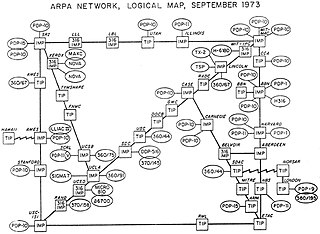Network Control Program might refer to:
- Network Control Program (ARPANET) - the software in the hosts which implemented the original protocol suite of the ARPANET, the Network Control Protocol
- IBM Network Control Program
Network Control Program might refer to:

The history of the Internet has its origin in information theory and the efforts to build and interconnect computer networks that arose from research and development in the United States and involved international collaboration, particularly with researchers in the United Kingdom and France.
Internetworking is the practice of interconnecting multiple computer networks, such that any pair of hosts in the connected networks can exchange messages irrespective of their hardware-level networking technology. The resulting system of interconnected networks are called an internetwork, or simply an internet.
The Internet protocol suite, commonly known as TCP/IP, is the set of communication protocols used in the Internet and similar computer networks. The current foundational protocols in the suite are the Transmission Control Protocol (TCP) and the Internet Protocol (IP), as well as the User Datagram Protocol (UDP).
Chaosnet is a local area network technology. It was first developed by Thomas Knight and Jack Holloway at MIT's AI Lab in 1975 and thereafter. It refers to two separate, but closely related, technologies. The more widespread was a set of computer communication packet-based protocols intended to connect the then-recently developed and very popular Lisp machines; the second was one of the earliest local area network (LAN) hardware implementations.
The end-to-end principle is a design framework in computer networking. In networks designed according to this principle, guaranteeing certain application-specific features, such as reliability and security, requires that they reside in the communicating end nodes of the network. Intermediary nodes, such as gateways and routers, that exist to establish the network, may implement these to improve efficiency but cannot guarantee end-to-end correctness.

The Advanced Research Projects Agency Network (ARPANET) was the first wide-area packet-switched network with distributed control and one of the first networks to implement the TCP/IP protocol suite. Both technologies became the technical foundation of the Internet. The ARPANET was established by the Advanced Research Projects Agency (ARPA) of the United States Department of Defense.
NCP may refer to:
Network Control Protocol might refer to:
The Network Control Protocol (NCP) provided the middle layers of the protocol stack running on host computers of the ARPANET, the predecessor to the modern Internet.

Robert Elliot Kahn is an American electrical engineer, who, along with Vint Cerf, first proposed the Transmission Control Protocol (TCP) and the Internet Protocol (IP), the fundamental communication protocols at the heart of the Internet.
ICP may refer to:
The Defense Data Network (DDN) was a computer networking effort of the United States Department of Defense from 1983 through 1995. It was based on ARPANET technology.
In computer networking, a port is a number assigned to uniquely identify a connection endpoint and to direct data to a specific service. At the software level, within an operating system, a port is a logical construct that identifies a specific process or a type of network service. A port is identified for each transport protocol and address combination by a 16-bit unsigned number, known as the port number. The most common transport protocols that use port numbers are the Transmission Control Protocol (TCP) and the User Datagram Protocol (UDP).
The internet layer is a group of internetworking methods, protocols, and specifications in the Internet protocol suite that are used to transport network packets from the originating host across network boundaries; if necessary, to the destination host specified by an IP address. The internet layer derives its name from its function facilitating internetworking, which is the concept of connecting multiple networks with each other through gateways.

Pål Spilling was a Norwegian Internet pioneer and professor at the University of Oslo and the UNIK Graduate Center at Kjeller in Norway.
A communication protocol is a system of rules that allows two or more entities of a communications system to transmit information via any kind of variation of a physical quantity. The protocol defines the rules, syntax, semantics and synchronization of communication and possible error recovery methods. Protocols may be implemented by hardware, software, or a combination of both.
Remote Spooling Communications Subsystem or RSCS is a subsystem of IBM's VM/370 operating system which accepts files transmitted to it from local or remote system and users and transmits them to destination local or remote users and systems. RSCS also transmits commands and messages among users and systems.

SATNET, also known as the Atlantic Packet Satellite Network, was an early satellite network that formed an initial segment of the Internet. It was implemented by BBN Technologies under the direction of the Advanced Research Projects Agency.
A long-running debate in computer science known as the Protocol Wars occurred from the 1970s to the 1990s when engineers, organizations and nations became polarized over the issue of which communication protocol would result in the best and most robust computer networks. This culminated in the Internet–OSI Standards War in the late 1980s and early 1990s, which was ultimately "won" by the Internet protocol suite ("TCP/IP") by the mid-1990s and has since resulted in most other protocols disappearing.